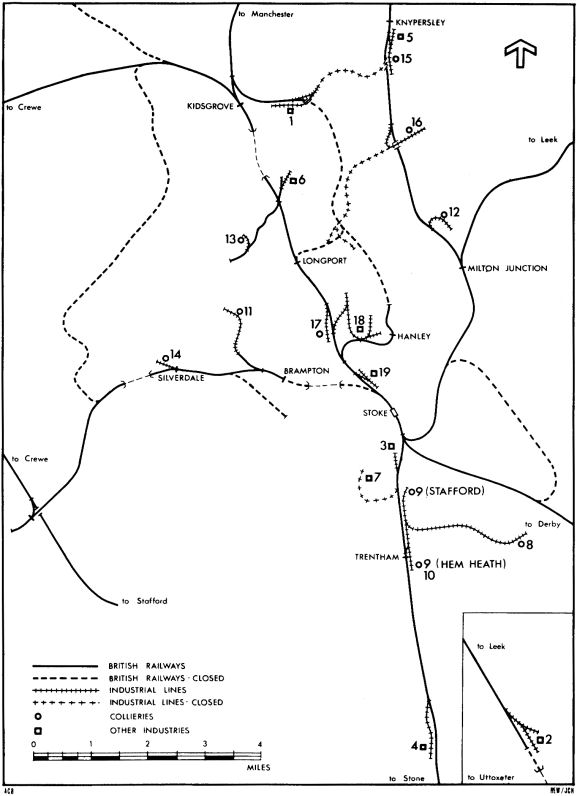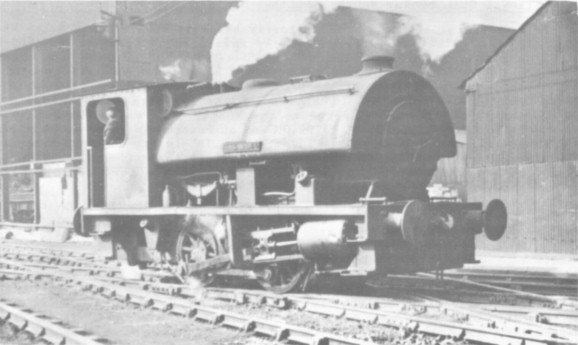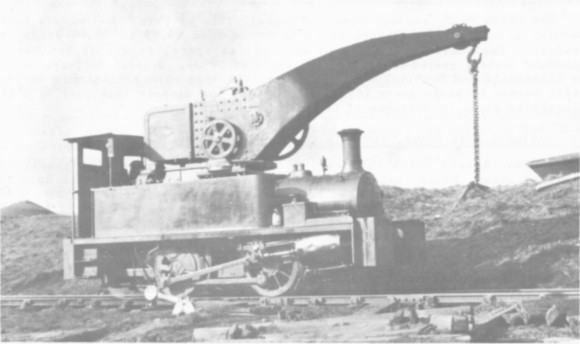
| THE INDUSTRIAL RAILWAY RECORD |
© FEBRUARY 1968 |
STANDARD GAUGE
IN
NORTH STAFFORDSHIRE -
1967
ALLAN C. BAKER
With but one exception the nineteen locations in North Staffordshire, having a total of sixty-nine standard gauge industrial locomotives, are concentrated in an area some nine miles long and six miles broad. It is thus a very convenient area both to study and visit, having a locomotive density of 1.26 per square mile. The exception referred to is British Industrial Sand Ltd at Oakamoor which appears on 1in Ordnance Survey sheet 111; all the others are on sheet 110. The locations are keyed to the accompanying map with the Grid reference (in brackets) wherever possible indicating the locomotive shed. All observations are correct to late 1967.
1 BIRCHENWOOD GAS AND COKE CO LTD, KIDSGROVE (849543)
The existing locomotive stock here numbers four and all are steam. Two are modern 0
−6−0 saddle tanks, with 16in by 24in outside cylinders – No.4 (Bagnall 2680 of 1944) and No.5 (Peckett 2153 of 1954) – which work Monday to Friday from 08.00 to 16.00 and occasionally on Saturday morning from 08.00 to 12.00. No.2 (Avonside 1382 of 1897), another 0−6−0 saddle tank but with inside cylinders 16in by 22in, is kept as spare engine in the large two road shed. The fourth member of the fleet, ALEXANDER, is a 14in by 20in 0−4−0 saddle tank (Bagnall 2107 of 1922). Officially "under repair", a new firebox is required and it seems doubtful whether it will in fact ever be steamed again. British railways reach this plant by a short line from Kidsgrove which runs parallel to the trackbed of the former Potteries Loop Line.2 BRITISH INDUSTRIAL SAND LTD, MONEYSTONE QUARRY, OAKAMOOR (047541)
This location provides the only traffic for British Railways between Leek Brook Junction and Oakamoor on the NSR Churnet valley line; the only other portion of this line still intact is the section between Leek Brook Junction and Leek. One of the two diesel locomotives here is used daily and the other is spare. The larger machine is an 0−4−0 by Stephenson & Hawthorne (6980 of 1940), the other being a 4−wheel chain-coupled Motor Rail "Simplex" (works number 4218).
3 BROOKFIELD FOUNDRY AND ENGINEERING COMPANY, CALIFORNIA WORKS, STOKE (882442)
Rail traffic has ceased at these works, formerly the erecting shops of Kerr, Stuart & Co Ltd, and the connection with British Railways has been severed. Of the three locomotives stored out of use the most interesting, in view of the location, is the 16in by 22in Kerr Stuart 0−4−0 saddle tank (4388 of 1926) which is the only example of the makers’ "Witch" class. She originally belonged to the local gas works, being supplied under the "Stoke on Trent (Gas Consolidation) Act, Contract No.35, Section No.7, Locomotive". Not without interest, however, is the other steam locomotive, a 13in by 18in 0−6−0 pannier tank which was built by Bagnall (2613 of 1940) for the Admiralty who formerly occupied these premises. NINA, a 4−wheel battery-electric machine built by Electromobile Leeds Ltd (W172 of 1925) is in exalted company. It is understood that all three locomotives are to be disposed of in 1968.

4 CENTRAL ELECTRICTY GENERATING BOARD, MEAFORD (889369)
This large modern power station has about nine miles of sidings and for the heavy shunting two quite massive 18in by 24in Stephenson & Hawthorns 0−6−0 side tanks are maintained. The traffic requires a locomotive in steam from 06.00 to 22.00 on seven days a week, and until 1966 the two side tanks worked this duty for alternate six-week periods. In that year the firebox of MEA No.1 (7683 of 1951) was condemned and no decision has yet been taken regarding the locomotive’s future. MEA No.2 (7745 of 1952) therefore works most of the time but has No.2 MURIEL, a 14in by 22in 0−4−0 saddle tank (Bagnall 2829 of 1946), as standby. The latter was originally built for this power station but is really too small for the work nowadays.
5 COWLISHAW, WALKER & CO LTD, BIDDULPH (879560)
This firm of engineers and ironfounders occupy the old erecting shops of Robert Heath & Low Moor Ltd, Biddulph Valley ironworks, where some seventeen locomotives were constructed and several others rebuilt. Cowlishaw Walker took over in 1928 when the ironworks closed down, and now uses for shunting a 4−wheel diesel (Drewry 2154 of 1939). When not at work it stands in the open.
6 GOLDENDALE IRON CO LTD, CHATTERLEY (851515)
This works is adjacent to the closed portion of the British Railways main line between Stoke and Kidsgrove at the south end of Harecastle tunnel, the new diversion line passing some distance to the west. Apart from those at Etruria (location 18) these are the last blast furnaces in operation in North Staffordshire, and require a locomotive in traffic for twenty-four hours a day and seven days a week. Two Ruston & Hornsby 175hp diesel hydraulics - WILLIAM (437361 of 1960) and EDWIN (437363 of 1960) - work this duty weeks about. RAVENSDALE (Yorkshire Engine Co 324 of 1881), a 12in by 20in 0−4−0 saddle tank, is the last survivor of a fleet of four, and can be seen from the road in a pile of scrap behind the new office block. She is the oldest industrial locomotive still extant in the area but has unfortunately lost her flat-top "ogee" tank and part of the boiler shell has been cut away.
7 MICHELIN TYRE CO LTD, STOKE-ON-TRENT (874478)
The private branch railway from the ex−NSR main line at Sideway was closed in 1962 and the track has been lifted. Latterly a Fowler diesel worked most of the traffic, but the earlier loco still remains. Although only a 4−wheel diesel electric it has some claim to fame for it was built in Paris by Gaston Moyse (104 of 1927); very few locos from this builder ever worked in Britain.
8 NATIONAL COAL BOARD, FLORENCE COLLIERY, LONGTOWN (915421)
Three similar 16in by 24in 0−6−0 saddle tanks of standard post-War Bagnall design at this colliery but none is in general use as shunting is carried out by diesels from Hem Heath. These reach Florence by a two-mile branch which is the last remaining industrial line in North Staffordshire. No.1 (2991 of 1950) is stored in the shed as recent efforts to repair her have been unsuccessful. FLORENCE No.2 (3059 of 1953) is in quite good order, however, and acts as spare engine while HEM HEATH No.2 (3078 of 1953), the last new steam locomotive in the area, lies disused outside the shed. The last two engines are fitted with Giesl ejectors.
9 NATIONAL COAL BOARD, HEM HEATH COLLIERY, TRENTHAM (882423)
The two road shed at this large modern colliery is host to nine diesels. Five (from 3D to 6D, 10D and 11D) work transfer traffic between the British Railways exchange sidings and Hem Heath and Stafford collieries (Stafford is a little to the north of Hem Heath) from 06.00 to 22.00 Monday to Saturday, and also on Sunday morning as required. From the D7 to D9 batch a sixth works the line to Florence colliery and a seventh shunts the screens there from 06.00 to 22.00 Monday to Friday (Saturday mornings as required) and often stays overnight. The other two locos are either spare or under repair. 3D to 6D, are 204hp 0−6−0 diesel mechanicals (Bagnall 3119 of 1956, and 3134-3136 of 1957); D7 to D9 are 300hp 0−6−0 diesel hydraulics (Ruston & Hornsby 506926, 513140 and 518495 of 1964, 1965 and 1966 respectively); 10D and 11D are "Vanguard" 300hp 6−wheel diesel hydraulic (Thomas Hill 168V and 179V of 1966 and 1967 respectively).
10 NATIONAL COAL BOARD, HEM HEATH AREA CENTRAL WORKSHOPS (888419)
These spacious workshops, in which several locomotives have been rebuilt, were built at the same time as the colliery and are situated at the rear of it. WILLIAM, a standard 16in by 24in 0−6−0 saddle tank (Bagnall 2681 of 1942) is at present standing in the stores compound out of use. It has been there since arriving in 1962 from the closed Sneyd colliery. The wheels have been used on FLORENCE No.2
11 NATIONAL COAL BOARD, HOLDITCH COLLIERY, NEWCASTLE (837479)
Holditch and Silverdale collieries provide the only traffic over the remaining section of the ex−NSR Stoke to Market Drayton branch between Brampton Siding and the Madeley "Chord" where connection is made with the main ex−LNWR Stafford to Crewe line. Three steam locos are kept here but one, a standard Sentinel 4−wheel geared-drive shunter (9534 of 1952) is withdrawn and stands in the open. Of the other two, one works 06.00 to 22.00 Monday to Friday with the other spare. DILHORNE No.3 is a standard Austerity 0−6−0 saddle tank (Bagnall 2787 of 1945) whilst CORNIST is a large 17in by 24in 0−6−0 side tank (Hudswell Clarke 1503 of 1923).


Shelton Ironworks on 3rd March 1957 when steam was still in the majority. HAWARDEN (Bagnall 2623 of 1940) and the un
−named crane tank (Dubs 4101 of 1901)(K.P.Plant)
12 NATIONAL COAL BOARD, NORTON COLLIERY (892508)
This is one of the collieries formerly owned by Robert Heath & Low Moor Ltd, and one of the locomotives built by this firm at Biddulph in 1885 is still here today. No.6, a 14in by 20in 0−4−0 saddle tank and the oldest serviceable industrial locomotive in North Staffordshire, is officially spare engine but it is doubtful whether it will ever work again. NORTON 1D, a 204hp 0−6−0 diesel mechanical (Bagnall 3092 of 1956) is the working loco; it was the first diesel delivered to the NCB in this area. On Monday to Friday it is in use from 06.00 to 22.00 and on Saturday morning as required. NORTON 2D (Bagnall 3093 of 1957), identical to 1D, awaits a new engine unit. The other loco not now in use, No.18, is a Hunslet Austerity (3160 of 1944), which the staff prefer not to steam as it is too big for the work here.
13 NATIONAL COAL BOARD, PARKHOUSE COLLIERY (839501)
As at Holditch there are three steam locos here but only one is used - from 08.00 to 17.00 Monday to Friday. No.3, a 16in by 24in Bagnall 0−6−0 saddle tank (2992 of 1950) is the working engine, having been recently transferred from Whitfield colliery; she was rebuilt at the Hem Heath Area Central Workshops in January 1962 and carries plates to that effect. BERRY HILL No.4, a similar Bagnall (3075 of 1954) is out of use outside the shed whilst BLYTHE No.1, a 16in by 24in Manning Wardle 0−6−0 saddle tank (1929 of 1917), is under repair inside the shed. There is some doubt whether the latter will ever work again.
14 NATIONAL COAL BOARD, SILVERDALE COLLIERY (813468)
HEM HEATH No.2, another standard Bagnall 16in by 24in 0−6−0 saddle tank, handles all the traffic here, being in steam from 06.00 to 22.00 Monday to Friday. The other loco, kept in the shed as spare, is one of Sentinel’s standard 4−wheel geared-drive shunters (9535 of 1952). British Railways trains to Silverdale and Holditch collieries were the only ones in the area in 1967 still worked by steam power (Class 8F 2−8−0’s) but diesels took over with the closure to steam in November of Crewe South shed.
15 NATIONAL COAL BOARD, VICTORIA COLLIERY, BIDDULPH (879556)
Another Robert Heath colliery, Victoria is now completely dieselised, the last steam, No.18, being transferred to Norton. The shed will hold six engines but only two are now based here, both being Ruston & Hornsby 300hp 0−6−0 diesel hydraulics built in 1965. VICTORIA D1 (512844) and VICTORIA D2 (512845) are both in use daily from Monday to Friday, one working from 06.00 to 16.00 and the other from 06.00 to 22.00.
16 NATIONAL COAL BOARD, WHITFIELD COLLIERY, TUNSTALL (882532 - steam) (882533 – diesel)
The once extensive system at this colliery is now but a shadow of its former self and only two locomotives (12D and 13D) are now required for yard shunting. Both are 6−wheel 300hp diesel hydraulics built by Thomas Hill in 1967, works numbers 180V and 181V. Both are in use daily from Monday to Friday, one from 06.00 to 22.00 and the other from 08.00 to 16.00. Two standard 16in by 24in Bagnall 0−6−0 saddle tanks, No.17 (2818 of 1945) and No.4 (3060 of 1953), which remain in the old steam shed are liable to transfer at any time.
17 NATIONAL COAL BOARD, WOLSTANTON COLLIERY (863475)
One of the newest collieries in the area, Wolstanton draws all the coal formerly worked by Sneyd and Hanley Deep pits. The large modern shed is host to three identical 204hp 0−6−0 diesel mechanical locos named WOLSTANTON No.1, No.2 and No.3 and built by Bagnall (3147, 3149 and 3150 of 1959). Two are used on Monday to Friday from 06.00 to 22.00 and on Saturday morning as required.
18 SHELTON IRON & STEEL LTD, ETRURIA, STOKE-ON-TRENT (874478 – ironworks) (874480 – coking plant)
A Beyer Peacock 0−4−0 saddle tank was at work here in 1856 and today it has the largest concentration of industrial locomotives in the area. Of the four steam locos, the 0−4−0 crane tank (Dubs 4101 of 1901) works seven days a week as required whilst HAWARDEN (Bagnall 15in by 22in 0−4−0 saddle tank, 2623 of 1940) shunts at the coking plant from 08.00 to 16.00 on Monday to Friday and from 08.00 to 12.00 on Saturday; the latter has been completely overhauled recently. HOLMBURY, a 14in by 22in 0−4−0 saddle tank built by Barclay and rebuilt at Shelton in 1913, and GLENALMOND, a similar loco built at Shelton in 1912, are kept as spares to the eleven diesels in normal daily use. The latter, of which some work for twenty-four hours a day, seven days a week, comprise four North British 225hp 0−4−0 diesel hydraulics named CORONATION, TIGER, LEOPARD and PANTHER, one North British 330hp 0−4−0 diesel hydraulics named LION, four Yorkshire Engine Co 200hp 0−4−0 diesel electrics named SQUIRREL, WEASEL, BADGER and OTTER, and three Yorkshire Engine Co 400hp 0−6−0 diesel electrics named JANUS, ATLAS and LUDSTONE. The last three handle the exchange traffic with British Railways at Grange Junction and Etruria yard.
19 WEST MIDLANDS GAS BOARD, STOKE GAS WORKS, ETRURIA (871465)
The two Fowler 150hp 0−4−0 diesel mechanical shunters kept here are not identical. GEORGE BARBER (4200038 of 1949) has a centre cab whilst GEORGE LE B. DIAMOND (4110005 of 1950) has the cab in the conventional place at the rear. One works from 08.00 to 18.00 daily and the other is spare.
* * *
Whilst it is not an industrial line, nobody visiting the area should fail to call at Dilhorne (978448) where the Foxfield Light Railway Society have their headquarters. Two locos are preserved here as well as a carriage and several wagons and are operated at weekends on part of the mineral line between Foxfield colliery (closed in August 1965) and Blythe Bridge some three miles distant. HENRY CORT, a Peckett 0−4−0 saddle tank (933 of 1903) came from the Irthlingborough ironstone mines of Richard Thomas & Baldwins Ltd in February 1967. Another 0−4−0 saddle tank, Hawthorn Leslie 3581 of 1924, arrived two months later from the Burton brewers, Marston, Thompson & Evershed Ltd.